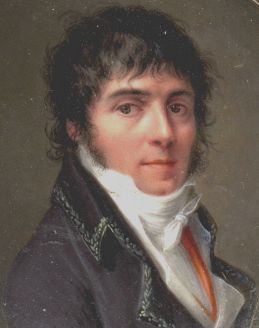Joseph Chinard facts for kids

Joseph Chinard (born in Lyon, France, on February 12, 1756 – died in Lyon on June 20, 1813) was a famous French sculptor. He created art in a style called Neoclassical, which means it was inspired by ancient Greek and Roman art. However, his sculptures also felt very real and showed lots of emotion.
Contents
Life of a Sculptor
Early Training and Rome
Joseph Chinard started his art journey in Lyon, France. He first learned to paint at a special art school supported by the government. Later, he worked with a local sculptor, learning how to shape materials into art.
His talent caught the eye of someone important who helped him travel to Rome, Italy, from 1784 to 1787. While there, he made copies of ancient Roman sculptures and sent them back to Lyon. He even won a special award from the Accademia di San Luca, which was a big honor for an artist who wasn't Italian. His winning sculpture, a clay piece called Perseus and Andromeda, is still kept at the Accademia today.
Challenges and Return to France
Chinard went back to Rome in 1791. During this time, the French Revolution was happening, and Chinard supported its new ideas. Some of his actions and art were seen as challenging by the authorities in Rome. For example, he displayed a clay model for a candle holder base that showed Apollo stepping on "Superstition." This was seen as going against the Pope's views.
Because of this, the Pope ordered him to be held at the Castel Sant'Angelo for two months. After he was released in December 1792, he was asked to leave Rome and returned to Dijon, France.
Famous Works and Later Life
Chinard created many important sculptures. His marble Bust of Madame de Verninac was first shown in plaster at the Paris Salon in 1800. The marble version was displayed in 1808. Chinard didn't travel to Paris very often, usually staying in Lyon or Italy.
However, during one trip to Paris, he sculpted a bust of Mme Récamier, a very famous woman of her time. This bust is now at the J. Paul Getty Museum and was also made into marble.
Chinard also made a clay bust of Pierre-Pomponne-Amédée Pocholle. The city of Lyon asked him to make this bust to thank Pocholle for being fair to the town when he worked there in 1794. Pocholle later took the bust with him when he moved and eventually gave it to his sister. She then donated it to a new museum in Neufchâtel-en-Bray in 1832, where it can still be seen.
Sadly, many of Chinard's large public sculptures in Lyon were destroyed during the French Revolution. However, his smaller, more personal sculptures, often made of clay or marble, showed families in a realistic and loving way.
Interest in Chinard's art grew again with a special exhibition of his sculptures in Paris in 1909-1910.
Today, you can find Joseph Chinard's sculptures in many famous museums around the world. These include the Louvre in Paris, the Musée des Beaux-Arts de Lyon, the Metropolitan Museum of Art in New York, and the National Gallery of Art in Washington D.C.
Works
- Laocoön and His Sons - Museum of Fine Arts of Lyon
- Saints Augustine and Paul, Museum of Fine Arts, Boston
-
Unknown bust, 1802, Louvre
-
A Lady, 1816, National Gallery of Art, Washington D.C.
-
Mme. de Verninac as Diana the Huntress, 1800s, Louvre
See also
 In Spanish: Joseph Chinard para niños
In Spanish: Joseph Chinard para niños






